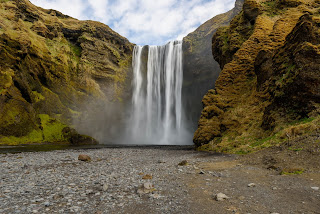Seljalandsfoss, Skógafoss, Dyrholaey, Arnardrangur, Reynisfjara, Vik I Myrdahl
It has been a big day. Lots of driving and lots of stops. A couple of waterfalls both very different from the earlier waterfalls. Churches and more churches. I hope that you don't get tired of churches. And the black sand of the southern coast.
As I'm driving to our first waterfall, I spot a church out in the country. I stop. It is Braeoratungukirkja.
Seljalandsfoss is a really cool waterfall. It is a 220 foot monster.
Skógafoss is 200 feet high and 80 feet wide. Guidebooks warn that the hard part of photographing here is getting a photo without any people. No problem today.
The nearby Skogar Museum has earthen houses once used by Icelanders
and a church.
They even have miniature houses and a miniature church for the kids. Notice the bones for the children to play with.
Now for the southern coast. Dyrholaey means door hole island. This is the view from a 380 foot promontory. It is raining.
Arnardrangur means eagle's rock. It is still raining.
Iceland has a motto that goes something like "when nature calls, don't call on nature". They are pretty good at locating WCs in tourist spots. Some are really up to date. But they are not free. They are connected to the internet (in the middle of nowhere it seems) and can take your credit card for the 20 Krone admission fee. Exit is free. Also notice the glass windows and social distancing.
Iceland was formed and is still being formed by volcanos. Evidence can be found not only in the volcanos but in the basalt columns from magma.
I found two churches by Reynisfjara.
And the church at Vik i Myrdahl is not to be missed.
And finally, just because I claim to be a photographer.
Oh, and about four and a half hours of driving today. I'm tired. Goodnight.




























So in the cemetery, are the graves usually raised like in one the pictures at Vik?
ReplyDeleteSo in the cemetery, are the graves usually raised like in one the pictures at Vik?
ReplyDeleteWhat kind of bones are those?
ReplyDelete